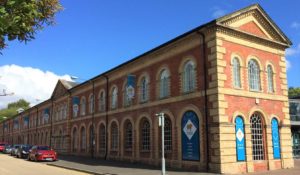
The Museum of Carpet at Kidderminster is a relative newcomer to the Midlands museum scene, having opened its doors to the public in 2012 after receiving a major Heritage Lottery Fund grant which enabled the conversation of a Grade II-listed building into a modern museum, complete with display galleries, archival space and rentable offices (to provide consistent income). It finally received accredited museum status from the Arts Council in 2022. Despite the youth of the museum, its collections tell of a long-established and deeply-rooted industry whose story is an important aspect of the Industrial Revolution.
Initially, the appetite for domestic embellishment, including carpets and other floor-coverings, was fuelled by families made newly wealthy by their participation in emerging industries. In the early- to mid-18th century, the incipient British carpet industry found sustenance in established weaving towns such as Wilton, Kirkcaldy, Halifax, Axminster and Kidderminster – the story of the latter being the focus of the museum.
Today, for most British people, the word ‘carpet’ evokes an image of a piled floor-covering, with soft velvety upright tufts, but initially the ‘carpets’ being woven in Kidderminster were flat-weave affairs: essentially, thick reversible woollen cloths, which were produced in narrow lengths and then sewn together length-wise to form floor-coverings. Piled carpets quickly followed, patterns became elaborate and over time technological developments improved both speed and quality of production. By the mid-19th century Kidderminster was internationally recognised as a centre of carpet production, and played its full role in the Midlands economy.
There then followed a century and a half of carpet-making, punctuated only by the World Wars, before decline set in during the latter decades of the 20th century. The stalling of the industry and visions of its demise prompted the foundation, in 1981, of the Carpet Museum Trust, a charitable organisation whose remit was to collect and to ‘save’ objects, paperwork and oral histories relating to the Kidderminster Carpet industry and – ambitiously – to set up a museum or museums to curate and display its collection. Much was gifted but it was not unknown for volunteers to retrieve items from skips or make a rapid response to quiet tip-offs that a particular company was going into receivership. For over two decades material was stored wherever space was available, be it garages, spare rooms, corners of industrial units or barns. Only when the Heritage Lottery grant was awarded could the long process of accessioning, cataloguing, conservation and – eventually – display begin. It is a work ongoing, for donations continue to be made, and the museum has an active collections policy.
As a result of such foresight and hard work, the Museum of Carpet now has a rich collection available to researchers and museum-goers. Two industrial power-looms in working order dominate the galleries and provide visitors with a sense of the noise, smells and visuals of life in the weaving sheds. This is a treat which depends upon the availability of retired skilled weavers willing to share their experience, so should not be missed. Elsewhere in the museum, pre-mechanised weaving is explored through demonstrations on wooden hand-looms; while the social and economic life of the town; and the design and the production process is also interpreted – with original design papers and carpets on display.
For researchers, the archived collection offers an invaluable variety of material. It includes design papers and sketches from the early 19th century to the 21st (including well-known designers from other spheres, such as C.F.A. Voysey and Lucienne Day); original art work purchased by the studios to provide inspiration for their designers (perhaps chief amongst them E. Glorget); there are order books; correspondence; advertising material; drawings and paintings; industrial objects; photographs documenting employees, special events, buildings; and, of course, rugs and carpets. The local newspaper, The Shuttle, is available for consultation in hard-copy from 1870 to 1982: as a newspaper which has not yet been digitised, this is an important resource for the history of the carpet industry, as well as this unique Midlands town.
For current opening hours, see the Museum’s website: https://museumofcarpet.org/ .
For research enquiries please be aware that some of the collection is stored off-site and that museum personnel are part-time and/or volunteers. It therefore is preferable to email collections@museumofcarpet.org.uk or telephone 01562 69028 at least a fortnight in advance of your anticipated visit.
Anthea Harris-Fry Researcher, Museum of Carpet
